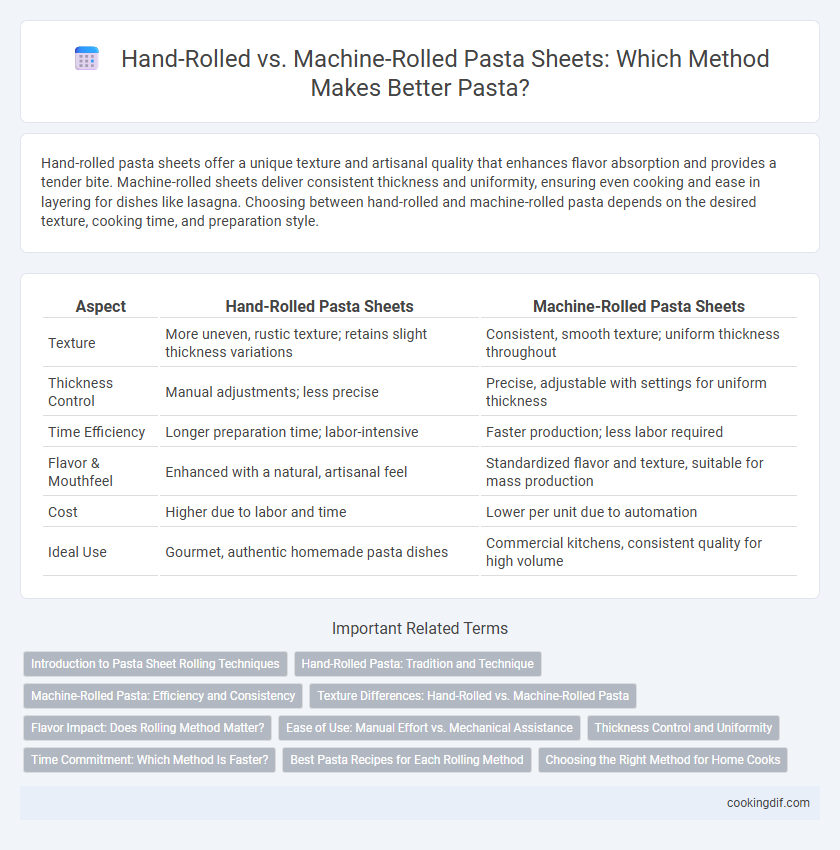Hand-rolled pasta sheets offer a unique texture and artisanal quality that enhances flavor absorption and provides a tender bite. Machine-rolled sheets deliver consistent thickness and uniformity, ensuring even cooking and ease in layering for dishes like lasagna. Choosing between hand-rolled and machine-rolled pasta depends on the desired texture, cooking time, and preparation style.
Table of Comparison
| Aspect | Hand-Rolled Pasta Sheets | Machine-Rolled Pasta Sheets |
|---|---|---|
| Texture | More uneven, rustic texture; retains slight thickness variations | Consistent, smooth texture; uniform thickness throughout |
| Thickness Control | Manual adjustments; less precise | Precise, adjustable with settings for uniform thickness |
| Time Efficiency | Longer preparation time; labor-intensive | Faster production; less labor required |
| Flavor & Mouthfeel | Enhanced with a natural, artisanal feel | Standardized flavor and texture, suitable for mass production |
| Cost | Higher due to labor and time | Lower per unit due to automation |
| Ideal Use | Gourmet, authentic homemade pasta dishes | Commercial kitchens, consistent quality for high volume |
Introduction to Pasta Sheet Rolling Techniques
Hand-rolled pasta sheets offer a traditional texture and thickness control that enhances authenticity and mouthfeel, while machine-rolled sheets ensure uniform thickness and speed for consistent results. Techniques for hand-rolling involve gradual flattening with a rolling pin, requiring skill to achieve even sheets, whereas machine rollers provide adjustable settings to customize pasta thickness efficiently. Understanding the differences in these rolling methods is crucial for selecting the appropriate technique based on desired pasta quality and production scale.
Hand-Rolled Pasta: Tradition and Technique
Hand-rolled pasta sheets exemplify traditional craftsmanship, offering a textured surface that better clings to sauces compared to machine-rolled sheets. The technique involves precise control over dough thickness and elasticity, achieved through repetitive rolling and folding by hand, which enhances the pasta's bite and mouthfeel. Artisanal chefs value hand-rolled sheets for their rustic quality and superior flavor absorption, preserving the authenticity of classic Italian cuisine.
Machine-Rolled Pasta: Efficiency and Consistency
Machine-rolled pasta sheets offer exceptional efficiency by speeding up production and minimizing manual labor, making them ideal for both commercial and high-volume home kitchens. The process ensures consistent thickness and texture across all sheets, enhancing cooking performance and dish quality. Advanced rollers can be adjusted precisely, delivering uniform pasta that cooks evenly and maintains structural integrity in sauces and fillings.
Texture Differences: Hand-Rolled vs. Machine-Rolled Pasta
Hand-rolled pasta sheets typically have a rougher texture, allowing sauces to cling better, resulting in more flavorful dishes. Machine-rolled pasta sheets possess a smoother, more uniform surface, which creates a tender and consistent bite ideal for delicate recipes. The choice between hand-rolled and machine-rolled pasta significantly impacts the mouthfeel and sauce absorption in pasta dishes.
Flavor Impact: Does Rolling Method Matter?
Hand-rolled pasta sheets often exhibit a slightly rougher texture that better holds sauces, enhancing overall flavor absorption compared to machine-rolled sheets, which tend to be smoother and more uniform. The tactile difference created by hand-rolling can intensify the pasta's ability to cling to rich, hearty sauces, elevating the taste experience. While machine-rolled pasta offers consistency and efficiency, hand-rolled sheets contribute subtle nuances in flavor through varied thickness and texture.
Ease of Use: Manual Effort vs. Mechanical Assistance
Hand-rolled pasta sheets require significant manual effort, demanding consistent pressure and technique to achieve uniform thickness, which can be time-consuming and physically taxing. Machine-rolled pasta sheets benefit from mechanical assistance, providing precise control over thickness with minimal physical exertion, making the process faster and more consistent. For ease of use, machine rolling is ideal for beginners and large batches, while hand-rolling suits traditionalists who prefer tactile control despite increased effort.
Thickness Control and Uniformity
Hand-rolled pasta sheets offer variable thickness that can add a rustic texture but often lack uniformity, while machine-rolled sheets ensure precise thickness control and consistent evenness essential for balanced cooking. Thickness discrepancies in hand-rolled pasta may lead to uneven cooking times, whereas machine-rolled pasta sheets provide reliable uniformity for perfect al dente results. Professional kitchens favor machine-rolled sheets for repeatable quality, whereas artisanal recipes emphasize the authentic texture of hand-rolled pasta.
Time Commitment: Which Method Is Faster?
Machine-rolled pasta sheets offer a significantly faster process, producing consistent thickness and smooth texture within minutes, ideal for high-volume cooking. Hand-rolling requires more time and effort, averaging 20 to 30 minutes to achieve uniform thinness, but allows greater control over dough thickness and artisanal texture. For time-efficient pasta preparation, machine-rolling is the preferred method without compromising quality.
Best Pasta Recipes for Each Rolling Method
Hand-rolled pasta sheets offer a delicate texture and uneven thickness that enhances sauces' absorption, ideal for classic dishes like homemade lasagna and ravioli filled with complex flavors. Machine-rolled pasta provides consistent thickness and smooth texture, perfect for recipes requiring uniform cooking such as fettuccine Alfredo or spaghetti carbonara. Selecting the rolling method influences the pasta's bite and sauce pairing, making it essential to match hand-rolled sheets with rustic, hearty recipes and machine-rolled sheets with recipes emphasizing precision and smoothness.
Choosing the Right Method for Home Cooks
Hand-rolled pasta sheets offer a traditional texture with slight variation, enhancing sauce adherence and providing an artisanal touch preferred by home cooks seeking authenticity. Machine-rolled sheets ensure uniform thickness and speed, making them ideal for consistent results and larger batches without sacrificing quality. Home cooks should balance desired texture, time constraints, and equipment availability when selecting between hand-rolled and machine-rolled pasta sheets.
Hand-rolled vs machine-rolled for pasta sheets Infographic

 cookingdif.com
cookingdif.com